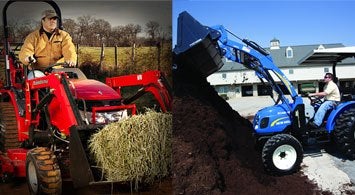
So you’re ready to move up to a tractor with diesel power, front end loader (FEL), and three-point hitch (3PH), but aren’t sure if a SCUT or a CUT best fits your needs. Which to choose? In this article we’ll cover the salient plusses and minuses of each and give you a check list to help make sure whatever you decide on will cover your specific needs.
A compact utility tractor is just that, a utility tractor scaled down to fit in smaller places and take up less storage space. The sub-compact tractor is a relatively new class, sized even smaller, but still offering hydraulic and engine power to get ground engaging jobs done. And since there is a perception by some that a sub-compact is just a glorified lawnmower, we’ll begin there.
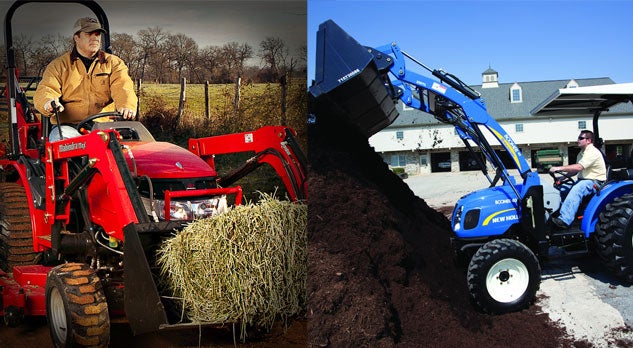
SCUT
This class of tractor was first introduced by Kubota in 2000 under the BX nomenclature. Power came from a three-cylinder diesel engine mated to hydrostatic transmission, which made operation automobile automatic transmission easy. 3PH lift capacity was limited, both by height due to the smaller tires and by the size of the package, though the ability to lift over 500 lbs using hydraulic power opened the door to a big range of possibilities. Like the 3PH, loader lift capacity was also matched to the physical package, but far exceeded what any wheelbarrow could handle. Purchasers of this new class of tractor could mow their lawns, till using a power take off (PTO) driven tiller, dig and transport a variety of materials using the FEL, and, when the going got tough, engage the 4WD system for added traction. No surprise, the class became a hit with the competition rushing in with SCUT models of their own. Today, almost every manufacturer offers a lineup of SCUT models with wide ranges of attachments and implements, up to and, in some cases, including small backhoes.
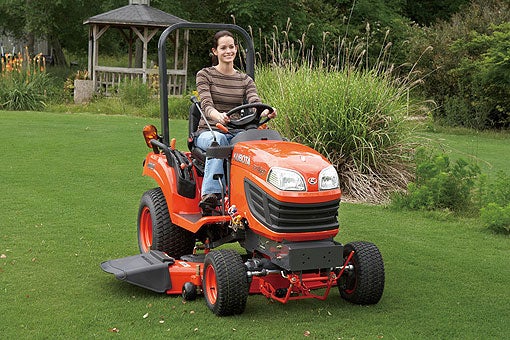 |
Basics
• 16 – 28 hp, diesel power
• 4WD
• Hydrostatic or gear transmission
• Cat-I 3PH
• Hydraulics: many tractors in this class will not have position control.
• Power steering
• Assortment of implements including mid-mount mower, snowblower, rear blade, rear rake, box blade, tiller
CUT
Compact utility tractors have been around since the 70s, and are an outgrowth of the farming needs in Japan where very little tillable soil is geographically available and the farm sizes are accordingly smaller. To get the maximum productivity from the available space, smaller, more maneuverable tractors were the solution. CUT machines then were generally no more than 40 horsepower with tractor weight below one ton. Today, the class has grown in power, with CUT models nearing 70 hp. Though the power has increased, the recipe has not: sturdy chassis, 20 – 50+ horsepower, 2WD and 4WD models, hydraulic power, gear and hydrostatic transmissions, and full size Cat-I 3PH, which means a wide range of readily available implements are compatible.
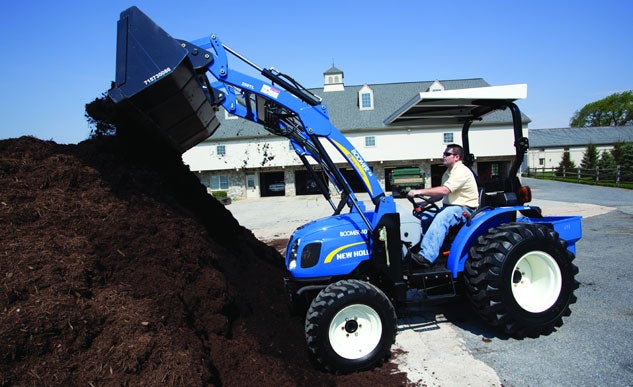
Basics
• Full frame, heavy duty construction
• 20 – 50+ hp, diesel power
• 4WD
• Hydrostatic or gear transmission; some models will have a shuttle shift option or a powershift option
• Hydraulics: most will be open center systems with separate pumps for implement and power steering needs. Options for additional rear remotes to run a hydraulic top link or rotate a snowblower chute. Option for additional front remotes to run a grapple or a loader mounted plow. Position control will be standard. Some tractors will have draft control as well
• Power steering
• Full range of Cat-I implements including post hole digger, backhoe, rotary cutter, planter/seeder. Implements will generally be bigger, more productive, and able to tackle larger tasks than on a SCUT
SCUT Plusses and Minuses
Plusses
• Maneuverable: wheelbase, frame and tires sized accordingly
• Light weight equals less turf damage, especially while turning
• Economical: diesels sip fuel compared to comparable horsepower gasoline engines, smaller sized implements cost less to manufacture, and the entire package is designed to last a long time (in many cases a lifetime)
• Requires minimal storage space
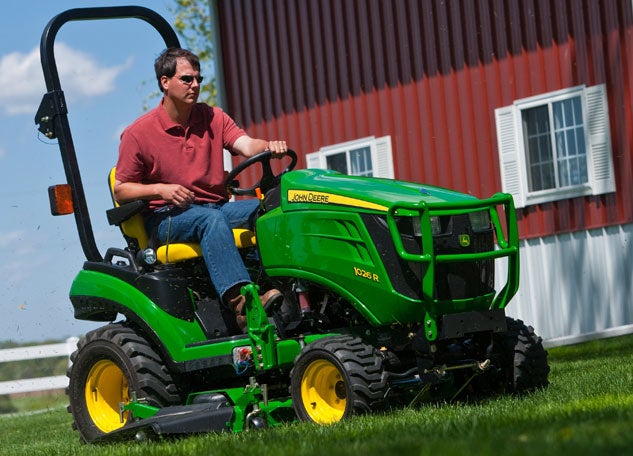
Minuses
• Smaller sized tires can ride more roughly
• Some SCUTs to hit price points have features reduced or removed. An example might be replacing precise 3PH position control with a guess where you’re at system
• Limited lift height on the 3PH may mean implements such as a post hole digger need to be specially sized (Limited Cat-I) and to get to the needed dig depth could require extensions that add time and extra energy to the job
CUT Plusses and Minuses
Plusses
• Larger wheelbase and frame allow larger implements to be used. Larger implements can cover more ground at higher speeds
• Position control will return an implement to an operator selectable position consistently and reliably
• Higher hydraulic flow rates at higher hydraulic pressures will lift more and operate faster
• Larger tires provide more traction, have greater ability to handle heavier loads, and will ride more comfortably over rough terrain
Minuses
• Implements that are larger can cost more
• Larger size and turning radius may be too large for some plots
• Turf damage may be increased due to size and weight, especially during turning
• Larger engines will use more fuel
• Larger engines may fall under EPA Final Tier IV (FT4) regulations that require systems such as a diesel particulate filter (DPF) and additions such as diesel exhaust fluid (DEF). Added emissions equipment adds complexity and cost
• Requires additional (more) storage space
• Larger tires require more horsepower to turn
If you’re getting the idea that a SCUT can do (almost) everything a CUT can, you are correct. The FEL bucket may hold less, the hydraulics may operate at lesser flow and pressure, there may be less transmission ranges, transport speed may be less, and implements may be sized smaller, but the end result is the same, just in smaller increments.
When John Deere came out with its first SCUT, the theme used was that the machine would move a mountain one bucket at a time. A CUT will do the same, just in larger increments and in quicker time.
Now that we’ve gone into some of the features differentiating SCUTs from CUTs, we’ll ask some questions that will help steer you to the class of machine that fits your needs best.
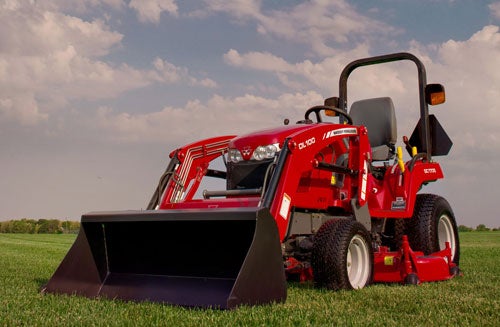 |
The first thing to determine is the predominate task the tractor will be used for. If mowing is your number one need and it will be on a groomed lawn, then a SCUT might better do the job with less turf damage. If you have large fields to maintain, a larger rotary cutter might be best, which favors the higher horsepower and platform size of a CUT.
• Mowing lawns – SCUT
• Mowing Fields – CUT
If loader work is a consideration, then you need to ask yourself how productive does this task need to be. If high productivity is a deciding factor, then a CUT is favored. If additional hydraulic options such as operating a grapple or using a loader mounted plow, then a CUT will be the better choice.
• Light loader work (SCUT)
• Heavy loader work (CUT)
If snow removal will be an important task, then consideration of several options will be helpful. Some prefer a front loader, which can pick up and move snow to another location, and build a pile when necessary. Others prefer to use a plow which is usually a faster method of clearing driveways. Still others will prefer using a snowblower, which can handle deep snow efficiently. A combination of these methods can also be employed. One example is a loader-mounted plow. Many of these systems use a quick change mount (skid-steer) which allows conversion from loader to plow work in minutes. A CUT would have advantages here.
Another combination is using a rear 3PH snowblower in tandem with the FEL bucket or a front blower and a rear 3PH blade. Most of these options will work with a SCUT as well as a CUT, but the sizing of the implement will be different.
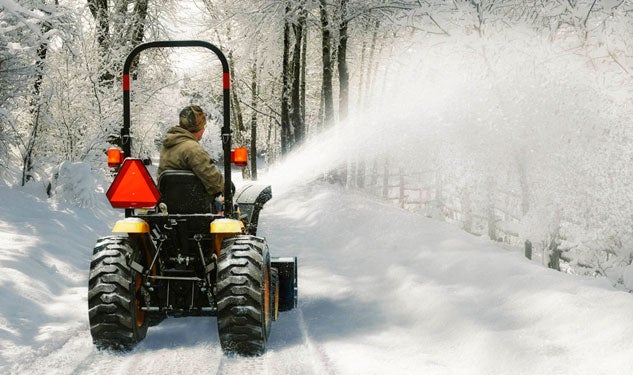
For serious winter working comfort, a Cab can’t be ignored. Cabs, both factory and aftermarket, have trickled down to SCUT models. Tapping into the tractor radiator can add heat and defrost capabilities. The disadvantage for a SCUT is when the season changes and temperatures rise. The old adage that a Cab without air conditioning is just a greenhouse rings true. Few SCUTs, if any, have the horsepower (and space) to add air conditioning. If a Cab with cooled air is a requirement, then a CUT is your choice.
• Small plow, snowblower or rear blade (SCUT)
• Larger plow, snowblower or rear blade (CUT)
• Cab heated but not air conditioned (SCUT)
• Cab with full HVAC (CUT)
If ground engaging activities (plowing and tilling) are an important consideration, then you’ll need to determine how large the implement need will be, and how quickly the task needs to be accomplished. Also, while a SCUT might be able to pull a two-bottom plow, the strain on the machine might be too much for long term reliability.
• Light ground engaging activities (SCUT)
• Heavy, repeated ground engaging activities (CUT)
Conclusion
As we’ve shown, a SCUT is far more than a glorified lawnmower. What can be accomplished with this relatively new class of machine is truly impressive. The quandary facing the prospective purchaser who is considering both classes is determining the primary task the tractor will be used for, and then how large implements they intend to use.
For some, if budgets allow, the answer might just be to bring home one of each. For most, the answer will be to accept some degree of compromise over size and task to be done.
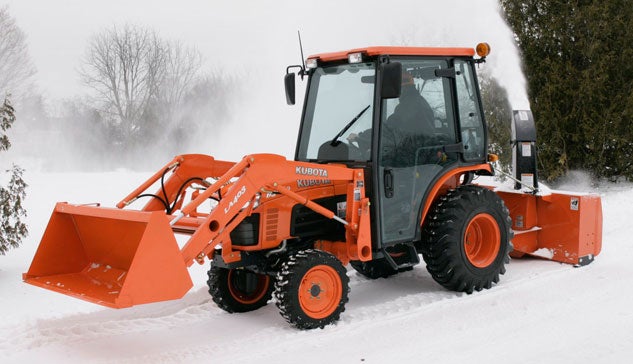
 Your Privacy Choices
Your Privacy Choices